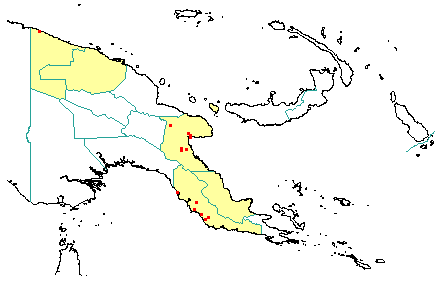
in PNGplants database
PNGTreesKey – Bombax ceiba L. |
Barry Conn (NSW) & Kipiro Damas (LAE).
Guide to trees of Papua New Guinea
Copyright held by the authors, National Herbarium of New South Wales, and Papua New Guinea National Herbarium
Species Plantarum 511 (1753)
Other Literature: J.R. Croft, Handbooks of the Flora of Papua New Guinea 5 (1981) Fig. 2.
Family: Malvaceae
Dicotyledon
Timber Group: Minor hardwood
Field Characters: Large canopy tree (up to 50 m high); Bole cylindrical (up to 1.2 m diam.) or slightly markedly fluted; straight (bole up to 45 m long); buttresses buttresses present or buttresses absent; spines spines present (on trunk of young trees) or spines absent; on trunk; aerial roots aerial roots absent; stilt roots stilt roots absent; Bark green, grey, or brown (greyish brown), rough, irregularly fissured or pustular, lenticels elongated vertically; Subrhytidome (under-bark) green or red (pale (with green stripes); sometimes less than 25 mm thick or mostly more than 25 mm thick, (10.0-) 20.0-30.0; bark blaze with two layers; faintly to non-aromatic; pleasant; outer blaze red or brown, with stripes (cream-coloured), fibrous; inner blaze pink, red, or brown, with stripes (orange), fibrous; bark exudate (sap) present, colourless, not readily flowing (spotty), colour changing on exposure to air, to brown, not sticky; terminal buds not enclosed by leaves.
Indumentum: Complex hairs present, star-like (stellate); stinging hairs absent; mature twig indumentum (hairs) present, hairs dense.
Leaves: Leaves spaced along branches, sub opposite (in pairs, opposite one another on the branchlet) or spiral (leaves occurring singly at a node and arranged spirally up the branchlet), compound (a leaf made up from two or more leaflets); petiole present, not winged, attached to base of leaf blade, not swollen; leaves with three leaflets (trifoliate) or palmate (with more than three leaflets attached at one point to the stalk); petiolule not swollen; leaves with a terminal leaflet (the number of leaflets odd - imparipinnate), broadest at or near middle or broadest below middle, 11.0-21.0 cm, 5.5-6.5 cm, leaflets arranged from one point, symmetric; venation pinnate, secondary veins open, prominent, intramarginal veins absent; leaves lower surface pale green, upper surface green (glossy), indumentum (hairs) absent (when old) or present when young, indumentum (hairs) dense (with star-shaped hairs); absent; domatia absent; stipules absent.
Flowers: Inflorescence on the trunk or branches (on leaf-less branchlets), flowers on an unbranched axis, cones absent; flowers bisexual, stalked, flowers with many planes of symmetry, 50.0 (c.) mm long, diameter large (more than10 mm diam.) (c. 50 mm diam.); perianth present, with distinct sepals and petals whorls, inner perianth red; 50, free; stamens 10 (c.), present, joined (near base), free of the perianth; ovary superior, carpels joined (when more than one), locules 5; styles solitary, 1.
Fruits: Infrutescence arranged on unbranched axis, fruit 100.0-150.0 mm long, dark brown, not spiny, non-fleshy, simple, dehiscent, capsule; seeds 100 (embedded in soft silky hairs), to about 5 mm long, not winged, narrow (longer than wide), seed 1-10 mm diam. (4-5 mm diam.).
Distribution: West Sepik, East Sepik, Morobe, Central & Northern.
 | Botanical records in PNGplants database |
Notes: Notes This species was previously classified in the family Bombacaceae.